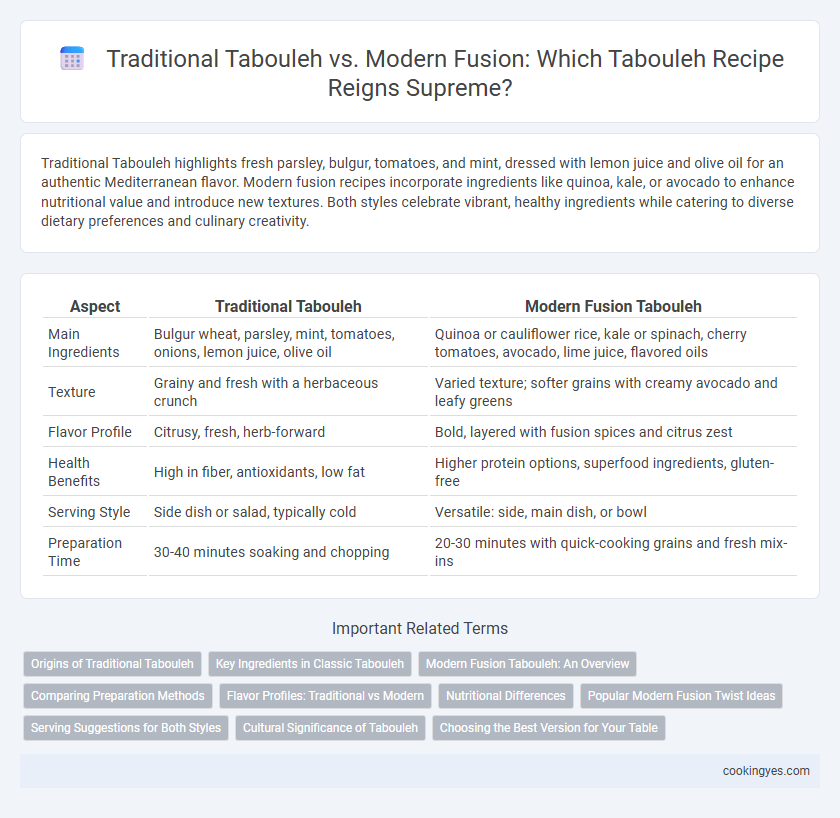Traditional Tabouleh highlights fresh parsley, bulgur, tomatoes, and mint, dressed with lemon juice and olive oil for an authentic Mediterranean flavor. Modern fusion recipes incorporate ingredients like quinoa, kale, or avocado to enhance nutritional value and introduce new textures. Both styles celebrate vibrant, healthy ingredients while catering to diverse dietary preferences and culinary creativity.
Table of Comparison
| Aspect | Traditional Tabouleh | Modern Fusion Tabouleh |
|---|---|---|
| Main Ingredients | Bulgur wheat, parsley, mint, tomatoes, onions, lemon juice, olive oil | Quinoa or cauliflower rice, kale or spinach, cherry tomatoes, avocado, lime juice, flavored oils |
| Texture | Grainy and fresh with a herbaceous crunch | Varied texture; softer grains with creamy avocado and leafy greens |
| Flavor Profile | Citrusy, fresh, herb-forward | Bold, layered with fusion spices and citrus zest |
| Health Benefits | High in fiber, antioxidants, low fat | Higher protein options, superfood ingredients, gluten-free |
| Serving Style | Side dish or salad, typically cold | Versatile: side, main dish, or bowl |
| Preparation Time | 30-40 minutes soaking and chopping | 20-30 minutes with quick-cooking grains and fresh mix-ins |
Origins of Traditional Tabouleh
Traditional Tabouleh originates from the Levant region, particularly Lebanon and Syria, where it is celebrated as a refreshing salad made primarily from finely chopped parsley, bulgur wheat, tomatoes, mint, lemon juice, and olive oil. This recipe emphasizes fresh, natural ingredients that highlight the Mediterranean diet's health benefits and vibrant flavors. Rooted in centuries-old culinary customs, traditional Tabouleh preserves regional authenticity through its simple, plant-based composition and symbolic representation of fertility and abundance.
Key Ingredients in Classic Tabouleh
Classic tabouleh features finely chopped parsley, bulgur wheat, fresh tomatoes, mint, lemon juice, and olive oil, creating a refreshing and herbaceous flavor profile. The traditional recipe emphasizes bulgur as the primary grain, providing a nutty texture that complements the bright acidity of lemon and the subtle sweetness of tomato. Modern fusion variations often replace bulgur with quinoa or couscous and incorporate additional ingredients like avocado or pomegranate seeds, but the authentic tabouleh's essence lies in its minimalist mix of parsley, bulgur, tomato, mint, lemon, and olive oil.
Modern Fusion Tabouleh: An Overview
Modern fusion tabouleh reimagines the traditional Levantine salad by incorporating diverse ingredients such as quinoa, kale, or avocados to enhance nutrition and flavor profiles. This contemporary version often substitutes bulgur with gluten-free grains, catering to dietary preferences while maintaining the classic balance of parsley, tomatoes, and lemon juice. Fusion tabouleh adapts to global culinary trends, offering inventive variations that appeal to health-conscious and adventurous eaters alike.
Comparing Preparation Methods
Traditional tabouleh preparation relies on soaking fine bulgur wheat to achieve a light texture, combined with finely chopped parsley, mint, tomatoes, onions, olive oil, and lemon juice, emphasizing fresh ingredients and minimal cooking. Modern fusion tabouleh often replaces bulgur with quinoa or cauliflower rice, incorporates diverse herbs like cilantro and basil, and may use alternative dressings, reflecting global flavor influences and convenience. Both methods prioritize freshness, but traditional preparation maintains classic textures and flavors, while fusion offers versatile adaptations suited for contemporary palates.
Flavor Profiles: Traditional vs Modern
Traditional tabouleh features a fresh, herbaceous flavor profile dominated by parsley, mint, and a bright lemony tang balanced with bulgur wheat's nutty texture. Modern fusion versions often introduce diverse ingredients like quinoa, kale, or exotic spices, creating complex, layered tastes that blend Middle Eastern zest with global culinary influences. The contrast lies in traditional tabouleh's clean, zesty simplicity versus modern variants' bold innovation and varied textures.
Nutritional Differences
Traditional tabouleh emphasizes fresh parsley, bulgur wheat, tomatoes, and lemon juice, creating a nutrient-dense dish rich in fiber, vitamin C, and antioxidants. Modern fusion recipes often substitute bulgur with quinoa or cauliflower rice, increasing protein content and reducing carbohydrates for a gluten-free alternative. The incorporation of new ingredients like avocado or kale enhances healthy fats and vitamin K, distinguishing the nutritional profile from the traditional version.
Popular Modern Fusion Twist Ideas
Traditional tabouleh features bulgur, parsley, mint, tomatoes, and lemon juice, emphasizing a fresh, herb-forward flavor profile. Popular modern fusion twists introduce quinoa or cauliflower rice as grain alternatives, enhancing nutritional value and texture variety. Other creative adaptations incorporate ingredients like pomegranate seeds, avocado, or roasted vegetables to add unique flavors and visual appeal.
Serving Suggestions for Both Styles
Traditional tabouleh is typically served as a refreshing side dish with pita bread, alongside grilled meats or mezze platters, emphasizing fresh parsley, bulgur, tomatoes, and lemon juice. Modern fusion tabouleh incorporates diverse ingredients like quinoa, kale, or avocado, often presented as a main salad or bowl with protein toppings such as grilled chicken or chickpeas for a more substantial meal. Both styles benefit from chilled serving and pairing with complementary dips like hummus or tahini to enhance the overall flavor profile.
Cultural Significance of Tabouleh
Traditional Tabouleh holds deep cultural significance in Levantine cuisine, symbolizing hospitality and communal gatherings with its emphasis on fresh parsley, bulgur, and a balanced lemon and olive oil dressing. Modern fusion variations incorporate diverse ingredients like quinoa or kale, reflecting global culinary trends while maintaining the essence of freshness and healthfulness that defines tabouleh. Both forms celebrate cultural identity through food, preserving heritage while embracing innovation.
Choosing the Best Version for Your Table
Traditional tabouleh features finely chopped parsley, bulgur wheat, tomatoes, mint, lemon juice, and olive oil, preserving authenticity and delivering a fresh, vibrant taste. Modern fusion tabouleh incorporates ingredients like quinoa, kale, or avocado, appealing to contemporary palates and dietary preferences while offering unique textures and flavors. Selecting the best version depends on your preference for classic Middle Eastern flavors or innovative, nutrient-rich adaptations suited for today's diverse culinary trends.
Traditional Tabouleh vs Modern Fusion for Tabouleh Recipe Infographic

 cookingyes.com
cookingyes.com